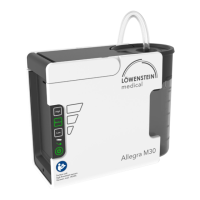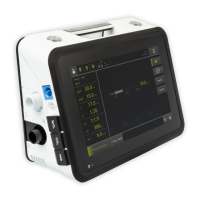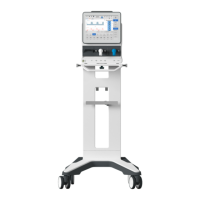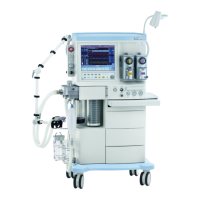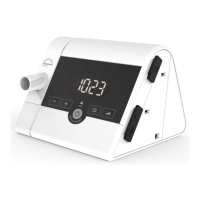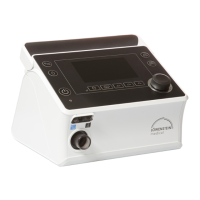Do you have a question about the Lowenstein Medical MiniScreen plus and is the answer not in the manual?
Details the intended use of the MiniScreen plus and premium systems for sleep diagnosis.
Lists cases where the device must be used under supervision of qualified medical personnel.
Describes the components of the MiniScreen system and its applied parts.
Provides crucial safety instructions and warnings for operating the device.
Covers manual usage, warranty, responsibility, and device handling guidelines.
Outlines recommended checks and maintenance for device safety and functionality.
Defines liability in case of improper use, repair, or non-observance of the manual.
Introduces the various sensors used for recording physiological data.
Explains the use of the flow prong for respiratory signals and snoring detection.
Describes the thermistor sensor for measuring breathing patterns.
Details the T-Adapter and pressure diff adapter for PAP therapy measurements.
Explains the integrated pulse oximeter for SpO2 and pulse rate measurement.
Describes pressure pad sensors for recording thorax and abdominal movement.
Details the position sensor for detecting patient body posture during studies.
Explains the RLS sensor for diagnosing restless or periodic leg movements.
Describes the ECG cable and its compatibility with adhesive electrodes.
Explains the Neuroport signal acquisition via EEG cable for MiniScreen plus.
Guides on preparing the device and patient for home-based ambulatory studies.
Details how the device automatically operates and how to manually switch it on/off.
Provides step-by-step instructions for applying sensors and preparing for measurement.
Explains the battery charging procedure using the provided adapter.
Outlines hygiene procedures for safe reuse of the system and its components.
Recommends device servicing every two years and initial calibration of the pressure channel.
Specifies the required ambient temperatures and humidity for transport and storage.
Guides on how to install the MiniScreen evaluation software from the supplied CD.
Explains how to select a printer and its driver for printing measurement curves and reports.
Describes the use of the Sleep Xpert App for visualizing curves on a tablet.
Provides solutions for common issues like missing channels, no flow signal, or no pulse oximeter response.
Lists part numbers and descriptions for spare parts and accessories.
Details the physical dimensions, weight, power, and environmental operating parameters.
Explains the meaning of various symbols used in the manual and on the device.
Provides guidelines and declarations related to electromagnetic compatibility (EMC) for the device.
Details compliance with electromagnetic emission standards and intended environment.
Presents test specifications and guidance for electromagnetic immunity.
Lists immunity test levels for RF disturbances and proximity fields.
Details the intended use of the MiniScreen plus and premium systems for sleep diagnosis.
Lists cases where the device must be used under supervision of qualified medical personnel.
Describes the components of the MiniScreen system and its applied parts.
Provides crucial safety instructions and warnings for operating the device.
Covers manual usage, warranty, responsibility, and device handling guidelines.
Outlines recommended checks and maintenance for device safety and functionality.
Defines liability in case of improper use, repair, or non-observance of the manual.
Introduces the various sensors used for recording physiological data.
Explains the use of the flow prong for respiratory signals and snoring detection.
Describes the thermistor sensor for measuring breathing patterns.
Details the T-Adapter and pressure diff adapter for PAP therapy measurements.
Explains the integrated pulse oximeter for SpO2 and pulse rate measurement.
Describes pressure pad sensors for recording thorax and abdominal movement.
Details the position sensor for detecting patient body posture during studies.
Explains the RLS sensor for diagnosing restless or periodic leg movements.
Describes the ECG cable and its compatibility with adhesive electrodes.
Explains the Neuroport signal acquisition via EEG cable for MiniScreen plus.
Guides on preparing the device and patient for home-based ambulatory studies.
Details how the device automatically operates and how to manually switch it on/off.
Provides step-by-step instructions for applying sensors and preparing for measurement.
Explains the battery charging procedure using the provided adapter.
Outlines hygiene procedures for safe reuse of the system and its components.
Recommends device servicing every two years and initial calibration of the pressure channel.
Specifies the required ambient temperatures and humidity for transport and storage.
Guides on how to install the MiniScreen evaluation software from the supplied CD.
Explains how to select a printer and its driver for printing measurement curves and reports.
Describes the use of the Sleep Xpert App for visualizing curves on a tablet.
Provides solutions for common issues like missing channels, no flow signal, or no pulse oximeter response.
Lists part numbers and descriptions for spare parts and accessories.
Details the physical dimensions, weight, power, and environmental operating parameters.
Explains the meaning of various symbols used in the manual and on the device.
Provides guidelines and declarations related to electromagnetic compatibility (EMC) for the device.
Details compliance with electromagnetic emission standards and intended environment.
Presents test specifications and guidance for electromagnetic immunity.
Lists immunity test levels for RF disturbances and proximity fields.
| Recording Parameters | SpO2, pulse rate, body position |
|---|---|
| Data Transfer | USB |
| Connectivity | USB |
| Data Storage | Internal memory |
| Intended Use | Screening for sleep apnoea and hypoventilation |
